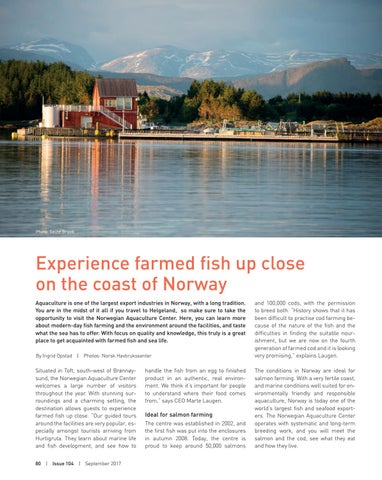Scan Magazine | Special Theme | Autumn & Winter Experiences in Norway
Photo: Gaute Bruvik
Experience farmed fish up close on the coast of Norway Aquaculture is one of the largest export industries in Norway, with a long tradition. You are in the midst of it all if you travel to Helgeland, so make sure to take the opportunity to visit the Norwegian Aquaculture Center. Here, you can learn more about modern-day fish farming and the environment around the facilities, and taste what the sea has to offer. With focus on quality and knowledge, this truly is a great place to get acquainted with farmed fish and sea life. By Ingrid Opstad | Photos: Norsk Havbrukssenter
and 100,000 cods, with the permission to breed both. “History shows that it has been difficult to practise cod farming because of the nature of the fish and the difficulties in finding the suitable nourishment, but we are now on the fourth generation of farmed cod and it is looking very promising,” explains Laugen.
Situated in Toft, south-west of Brønnøysund, the Norwegian Aquaculture Center welcomes a large number of visitors throughout the year. With stunning surroundings and a charming setting, the destination allows guests to experience farmed fish up close. “Our guided tours around the facilities are very popular, especially amongst tourists arriving from Hurtigruta. They learn about marine life and fish development, and see how to
The conditions in Norway are ideal for salmon farming. With a very fertile coast, and marine conditions well suited for environmentally friendly and responsible aquaculture, Norway is today one of the world’s largest fish and seafood exporters. The Norwegian Aquaculture Center operates with systematic and long-term breeding work, and you will meet the salmon and the cod, see what they eat and how they live.
80 | Issue 104 | September 2017
handle the fish from an egg to finished product in an authentic, real environment. We think it’s important for people to understand where their food comes from,” says CEO Marte Laugen.
Ideal for salmon farming The centre was established in 2002, and the first fish was put into the enclosures in autumn 2008. Today, the centre is proud to keep around 50,000 salmons
